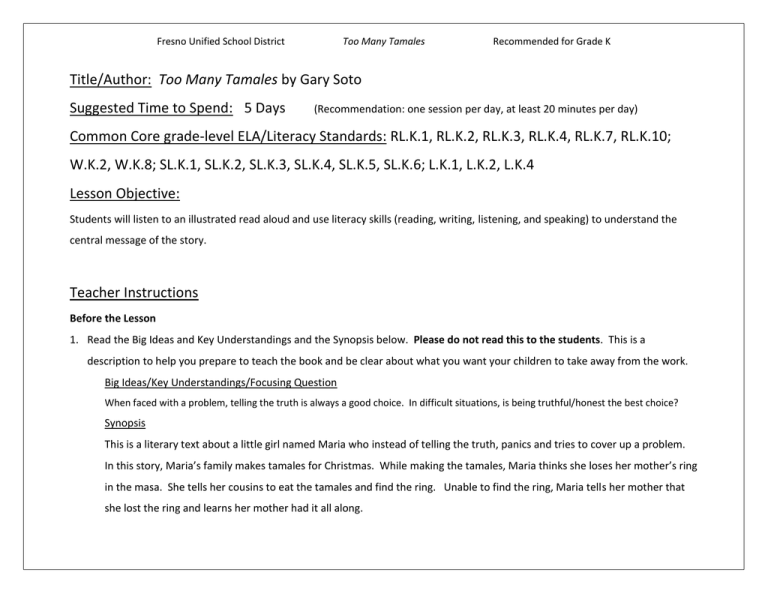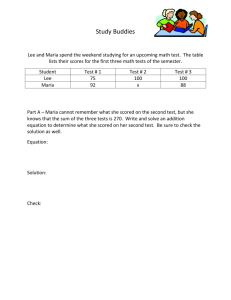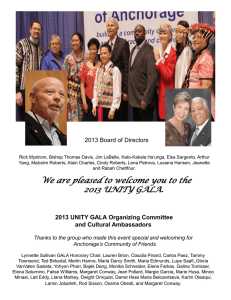Too Many Tamales - Achieve the Core
advertisement

Fresno Unified School District Too Many Tamales Recommended for Grade K Title/Author: Too Many Tamales by Gary Soto Suggested Time to Spend: 5 Days (Recommendation: one session per day, at least 20 minutes per day) Common Core grade-level ELA/Literacy Standards: RL.K.1, RL.K.2, RL.K.3, RL.K.4, RL.K.7, RL.K.10; W.K.2, W.K.8; SL.K.1, SL.K.2, SL.K.3, SL.K.4, SL.K.5, SL.K.6; L.K.1, L.K.2, L.K.4 Lesson Objective: Students will listen to an illustrated read aloud and use literacy skills (reading, writing, listening, and speaking) to understand the central message of the story. Teacher Instructions Before the Lesson 1. Read the Big Ideas and Key Understandings and the Synopsis below. Please do not read this to the students. This is a description to help you prepare to teach the book and be clear about what you want your children to take away from the work. Big Ideas/Key Understandings/Focusing Question When faced with a problem, telling the truth is always a good choice. In difficult situations, is being truthful/honest the best choice? Synopsis This is a literary text about a little girl named Maria who instead of telling the truth, panics and tries to cover up a problem. In this story, Maria’s family makes tamales for Christmas. While making the tamales, Maria thinks she loses her mother’s ring in the masa. She tells her cousins to eat the tamales and find the ring. Unable to find the ring, Maria tells her mother that she lost the ring and learns her mother had it all along. Fresno Unified School District Too Many Tamales Recommended for Grade K 2. Go to the last page of the lesson and review “What Makes this Read-Aloud Complex.” This was created for you as part of the lesson and will give you guidance about what the lesson writers saw as the sources of complexity or key access points for this book. You will of course evaluate text complexity with your own students in mind, and make adjustments to the lesson pacing and even the suggested activities and questions. 3. Read the entire book, adding your own insights to the understandings identified. Also note the stopping points for the textinspired questions and activities. Hint: you may want to copy the questions vocabulary words and activities over onto sticky notes so they can be stuck to the right pages for each day’s questions and vocabulary work. The Lesson – Questions, Activities, and Tasks Questions/Activities/Vocabulary/Tasks FIRST READING: Read aloud the entire book (or chapter) with minimal interruptions. Stop to provide word meanings or clarify only when you know the majority of your students will be confused. Expected Outcome or Response (for each) The goal here is for students to enjoy the book, both writing and pictures, and to experience it as a whole. This will give them some context and sense of completion before they dive into examining the parts of the book more carefully. SECOND READING: Reread story in its entirety. Then focus your questions on pages 1-11. As you reread page 2-3, ask How is Maria acting grown-up? “She was acting grown-up now, helping her mother make tamales.” “She felt grown-up wearing her mother’s apron. Her mom had even let her wear lipstick and perfume.” Fresno Unified School District Too Many Tamales Recommended for Grade K What are Maria and her mother making? Maria and her mother are making tamales. What are tamales? Tamales are a Mexican dish made with meat tucked in dough wrapped in corn husks. Teacher uses pictures or realia to show what a tamale is? (realia - props or activities used to relate education to real life.) Reread page 3. What does “kneaded” mean? What is she kneading? How do you think the masa feels? Look at the illustration on page 5. What is Maria thinking? Can we tell by the expression on her face? Reread pages 6-7. What did Maria say to herself? Reread page 8. What does the author mean when he says, “the ring disappeared and reappeared in the sticky glob of dough?” The teacher can model this by kneading play dough and showing how the ring on his/her finger disappears and reappears. Students should infer from the pictures that “kneaded” means to work dough with your hands by pressing and stretching. (Teacher models with play dough while students mimic teacher’s actions.) Students should make the inference that Maria is thinking about the ring. The text states “She loved how it sparkled …” We can tell by her raised eyebrows and lips like she is saying, “Ooohh.” “I’ll wear the ring for just a minute” You can’t see the ring and then you can. It was swallowed up. The ring was on Maria’s finger. As she kneaded the dough, the ring on her finger appeared when she pulled her hand out of the dough and disappeared as her hand went into the dough. As you reread page 9, ask What does “spread the masa” mean? What other things can be “Spread the masa” means to stretch out the masa over the spread? husk. “Spread” means to stretch out over a surface or to apply. Fresno Unified School District Too Many Tamales Recommended for Grade K Students think-pair-share things that can be “spread” as the teacher charts their answers. For example, we spread butter on toast or peanut butter on a sandwich. Teacher will show the video demonstrating how to spread masa on a corn husk. http://www.youtube.com/watch?v=MhhLg-aEUSc Pretend you are spreading masa to make tamales. Teacher and students pantomime spreading masa. Activity: During small group time, children practice kneading play dough. Give each child a bowl, play dough, and a toy ring. Show the children how to knead the dough using their hands. Demonstrate the “pumping up and down” motion. Model the “disappearing and reappearing” of the ring on your finger into the dough. THIRD READING: Reread pages 12-21. After reading page 12-13, look carefully at the illustration. What do you think “a shock spread through her body” means? Think about a time when you felt shocked. Turn to your partner and tell them about a time when you felt shocked. Maria realized something important. Shocked means to make someone feel surprised and upset. Show me your “shocked” face. Why is Maria shocked? She realized that she lost the ring. How is the term “spread” used here differently to when the author stated “spread the masa”? “Spread” in this sentence means “to become known.” The feeling What made Maria remember the ring? of “shock” is being felt throughout her body. She remembers the ring when she sees the picture of the pearl necklace. The text states, “As Maria was snipping out a picture of a pearl Fresno Unified School District Too Many Tamales Why did the picture of the pearl necklace remind her of the ring? Recommended for Grade K necklace, …” Guide students to infer that the pearl necklace is jewelry. Activity Where do you think the ring is? Think-Pair-Share- Students tell their partner where they think the ring is. Teacher asks several pairs to share what they discussed. She thinks the ring is in one of the tamales Where does Maria think the ring is? Maria lost her mother’s ring. After reading pages 14-15, ask What is Maria’s problem? Students share multiple answers as teacher charts. Activity How can Maria solve her problem? Teacher charts the problem and students suggestions for solutions to the problem. Sample Problem-Solution Chart Problem Possible Solution Maria lost her mother’s Record students’ suggestions. ring. Responses may include: She could tell her mother. She could try to find the ring. She could say nothing at all. Students with a partner discuss which solution each would choose from the chart. Students share the solution they chose. Fresno Unified School District Too Many Tamales Recommended for Grade K How did Maria choose to solve the problem? At first, Maria had her cousins eat the tamales “What do you want us do?” “Eat them,” she said. “If you bite something hard, tell me.” Why didn’t Maria tell her mother about the ring? Students infer: She was afraid she would get in trouble. After reading page 16, ask Did Maria’s cousins agree to help her? How? Yes, the text states, “The four of them started eating.” What does the author mean when he says “they were tired of the taste?” “The first one was good. The second one pretty good, but by the third tamale, they were tired of the taste.” Activity Have the students think of a time that they ate so much of something that it no longer tasted good. Choose three or four students to dramatize this part of the story, showing facial expressions and body language. What did the author mean when he said, “Their stomachs were stretched till they hurt”? The author means that they were too full. They had a lot to eat. Activity Students pantomime having very full stomachs. After reading page 18, ask Why were they only able to take 1 bite of the last tamale? They were so full that they couldn’t eat anymore. Fresno Unified School District Too Many Tamales Recommended for Grade K After reading page 20, ask Did the cousins find the ring? No, they did not find the ring in the tamales. The text states “Nothing.” Where did they think the ring is? Danny frowned, “I think I swallowed something hard,” he said. “Swallowed it!” Maria cried, her eyes big with worry. She looked inside his mouth. They think Danny swallowed the ring. FOURTH READING: Reread pages 22-30 After reading page 22-23 Look at Maria’s face and body language. How do you know what Maria is thinking? After reading page 25 Why did Maria finally tell her mother about the ring? What does “confess” mean? We know she feels sad because the text states, “She could feel tears pressing to get out as she walked into the living room where the grownups sat talking.” She is looking down and her fists are clinched. Maria felt bad that she couldn’t find the ring. “Maria thought about the beautiful ring now sitting inside Danny’s belly, and got ready to confess.” Confess means to tell someone the truth. Activity: Think-Pair-Share Think of a time you confessed about something that you did wrong. Discuss with your partner. Read the sentence, “’I did something wrong,’ Maria sobbed.” What do you think “sobbed” means? Look at the picture. Sobbed means to cry. Have students pantomime “sobbing.” Fresno Unified School District Too Many Tamales Recommended for Grade K After reading page 26-27, ask How do the adults react to Maria’s situation? How do you know they are not angry? The adults did not get angry at Maria. The adults are smiling at Maria and helping her make more tamales. Listen to the sentence, “Well, it looks like we all need to cook up another batch of tamales.” What does “batch” mean? A batch is a lot of something or a bunch of something. After reading page 28-29, have students look at the illustration. What is Maria doing? Why did she feel like crying? After reading page 30, ask How is Maria feeling now? Why? She is kneading the masa. She is helping her family make more tamales. “At first she still felt like crying as she kneaded a great bowl of masa, next to Aunt Rosa.” She was embarrassed and felt guilty for not telling the truth earlier. Maria is feeling better because her problem was solved and everything was okay. The text states, “Then Maria couldn’t help herself: She laughed.” Why is Maria feeling better? Maria is feeling better because her problem was solved and she was surrounded by her loving family. What did Maria learn in this book? Maria learned that it is better to tell the truth. Fresno Unified School District Too Many Tamales Recommended for Grade K Activity Teacher tells a personal scenario about a time he/she told the truth in a difficult situation. Students think-pair-share about a time they did something wrong and had to tell the truth (or should have told the truth). Teacher charts student responses. FINAL DAY WITH THE BOOK - Culminating Task Prompt o What is the lesson in this story? Use pictures and words to show what you learned from this book. Provide a paper to draw and write. Students use pictures and/or writing to show how Maria was truthful/honest. Sample answer o “It is good to tell the truth when you have a problem. Maria told her mom that she lost the ring and her mom was not mad.” Students may draw a picture of Maria telling her mother the truth. Students may write their response or dictate their response using the picture that they drew. Fresno Unified School District Too Many Tamales Recommended for Grade K Vocabulary These words merit less time and attention These words merit more time and attention (They are concrete and easy to explain, or describe events/ processes/ideas/concepts/experiences that are familiar to your students ) (They are abstract, have multiple meanings, and/or are a part of a large family of words with related meanings. These words are likely to describe events, ideas, processes or experiences that most of your student will be unfamiliar with) Page 2 - masa - dough Page 2 - tamales - traditional Mexican dish usually eaten during holidays Page 25 – sobbed - cried Truthful - telling or expressing the truth (what really happened) Page 3 - kneaded – to work into a uniform mixture by pressing, folding, and stretching Page 9 - spread – to distribute over a greater or relatively great area of space or time Page 12- shock - a sudden disturbance of the mind, emotions, or sensibilities Page 25 - confess - to admit to something true Page 27- batch - the quantity of bread, cookies, dough, or the like, made at one baking Fun Extension Activities for this Book and Other Useful Resources Dramatic Retell: Choose students to be the characters of the book: Maria, her mother, her father, her three cousins, aunts and uncles. As the teacher reads, students act out the story using props (apron, masa /dough, bowl, toy ring, pot). Extending Our Thinking: Ask students to think about a time when they did something wrong or made a mistake and tried to cover it up instead of asking for help. What happened? Did they get in trouble? Would it have been better if they’d just been honest in the first place? Fresno Unified School District Too Many Tamales Recommended for Grade K Dramatic Play Area: In the dramatic play area place items to act out the story such as an apron, a play ring, masa (play dough), pots, platter, corn husks, rolling pin, utensils, etc. Math: The children in the story had 24 tamales to eat in order to find the ring. There were 4 children. How many tamales did each child eat? Students can use corn husks or play dough to represent the tamales and come up with combinations of numbers to make 24. You may reduce the number of tamales to match your students’ level if needed. Art: Corn Husk painting: Allow corn husks to dry overnight. Dip the end of the corn husks in paint and use as a paint brush. Corn Husk Dolls: Follow this link to step by step instructions on how to make corn husk dolls. http://www.kiwicrate.com/projects/Corn-Husk-Doll/756 Fine Motor: Hide plastic rings in dough and then shape the dough into tamales. Children look for the rings by kneading the dough with their fingers. Videos and Music: o This is a video of the book being read: http://www.youtube.com/watch?v=0rH07LmKXM0 o “Honesty,” a song about being choosing to be honest by Kindersongs: http://www.youtube.com/watch?v=9SFe6O29P3E o “All About Honesty,” a song about honesty and telling the truth. http://www.youtube.com/watch?v=jwhpoBw59XY Fresno Unified School District Too Many Tamales Recommended for Grade K Make a class cookbook: Have the students bring family recipes from home. Compile the recipes into a class cookbook. Send copies of the cookbook home with the students to share with their families. Family Project: In the story, Too Many Tamales, we learned about the tradition of making tamales for Christmas that is practiced by many Mexican families. Have children explore their own family holiday traditions. With their family, have the students create a poster board to show family traditions their own family has for the holidays. Students can add drawings, photographs, or realia (models or real life objects) to show their tradition. Students present their poster board to the class and talk about their family traditions. Cooking: Make tamales with the class. Ask parents or other volunteers to donate supplies and/or help. Record the steps taken to make the tamales. Fresno Unified School District Too Many Tamales Recommended for Grade K What Makes This Read-Aloud Complex? 1. Quantitative Measure Go to http://www.lexile.com/ and enter the title of your read-aloud in the Quick Book Search in the upper right of home page. Most texts will have a Lexile measure in this database. 670L Most of the texts that we read aloud in K-2 should be in the 2-3 or 4-5 band, more complex than the students can read themselves. 2-3 band 420-820L 4-5 band 740-1010L 2. Qualitative Features Consider the four dimensions of text complexity below. For each dimension *, note specific examples from the text that make it more or less complex. Sophisticated graphics which are essential to the understanding of the text: facial expressions, illustrations Truthfulness “How in the world can she tell her mother? But I have to, she thought.” When faced with a problem, being truthful/honest is the best choice. Meaning/Purpose Figurative language: Language “curls of steam,” “sparkled like Christmas tree lights,” “shock spread through her body,, “piped up,” “Their stomachs were stretched till they hurt” Many of the messages and essential understandings are implicit. Multiple perspectives (Maria, cousins, adults, reader) Structure Knowledge Demands Experiences may differ from one’s own Hispanic cultural knowledge is helpful Domain specific vocabulary: tamales, masa, kneaded 3. Reader and Task Considerations What will challenge my students most in this text? What supports can I provide? The implicit purpose of the text and the figurative language will be a challenge for students. Build background on purpose of text through activities, recall, discussions, examples related directly to students. How will this text help my students build knowledge about the world? Students build knowledge about the world through the moralistic message of the story building on the ideas that “honesty” is the best choice when facing a problem. Students also learn about food and traditions of the Mexican culture. 4. Grade level What grade does this book best belong in? Kindergarten – Read-Alouds are a scaffold to give kindergarteners the ability to comprehend complex text that would otherwise be inaccessible. *For more information on the qualitative dimensions of text complexity, visit http://www.achievethecore.org/content/upload/Companion_to_Qualitative_Scale_Features_Explained.pdf




